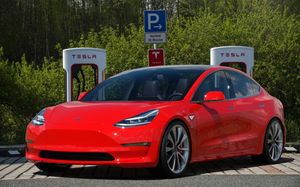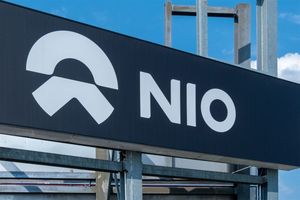
The world's leading technology behemoths, including Nvidia (NVDA), Alphabet (GOOGL), and Amazon (AMZN), are experiencing an unprecedented surge in buy-side interest, driven by the explosive growth and transformative potential of Artificial Intelligence. This fervent investor confidence is reshaping market dynamics, propelling valuations to new heights, and signaling a profound reordering of investment strategies centered around AI infrastructure and innovation. The immediate implication is a sustained bullish trend in technology stocks, yet it also sparks critical discussions about market concentration and the long-term sustainability of these valuations.
The Dawn of a New Economic Era: What Happened and Why It Matters
The current AI revolution has unleashed a torrent of capital into the technology sector, with investors eagerly backing companies poised to dominate this new frontier. What began as a nascent technological advancement a few years ago has rapidly accelerated into a full-blown economic transformation, with AI now seen as a crucial driver of efficiency, cost reduction, and new revenue streams across nearly every industry. This shift has culminated in an intense "AI arms race" among tech giants, each vying for supremacy in developing and deploying cutting-edge AI capabilities.
The timeline of this escalated interest can be traced through the increasing sophistication of AI models and their widespread integration. From the rise of advanced generative AI models in late 2022 to their commercial applications becoming mainstream in 2023 and 2024, the market has progressively recognized the immense potential. Key players like Nvidia (NVDA), the undisputed leader in AI-enabling Graphics Processing Units (GPUs), have seen their market capitalization soar, reaching unprecedented levels as the backbone of AI-focused data centers. Similarly, Alphabet (GOOGL) has demonstrated a remarkable resurgence, integrating its powerful Gemini AI models into core products like Chrome and Google Workspace, shifting investor sentiment from skepticism to overwhelming optimism about its AI future. Amazon (AMZN), through its robust Amazon Web Services (AWS) cloud platform, is investing heavily in AI infrastructure and partnering with leading AI firms like Anthropic, solidifying its role as a critical enabler and adopter of AI across its vast operations.
Initial market reactions have been overwhelmingly positive, with the "Magnificent Seven" tech stocks, spearheaded by these AI frontrunners, accounting for a significant portion of major index gains. This bullish sentiment reflects a collective belief that the consequences of "underbuilding" AI infrastructure are far more severe than "overbuilding," fueling a "fear of missing out" (FOMO) among institutional and retail investors alike. However, this concentrated surge also brings with it a cautious undercurrent, prompting analysts to question potential "bubble" dynamics and the long-term profitability of massive AI investments without broader economic returns. Nevertheless, the prevailing view remains that AI is not just a passing trend but a foundational shift, making these tech giants pivotal to the future economy.
The AI Gold Rush: Identifying the Winners and Those Left Behind
The AI boom has created a clear distinction between companies poised for exponential growth and those struggling to adapt, with tech giants firmly positioned as the primary beneficiaries. Their strategic investments, expansive ecosystems, and crucial infrastructure are cementing their roles as leaders in this transformative era.
Nvidia (NVDA) stands as a foundational winner, largely due to its unparalleled dominance in Graphics Processing Units (GPUs), which are indispensable for training and deploying complex AI models. Its data center segment saw revenue surge to $41.1 billion in Q2 FY2026, driven by demand for its Hopper, Blackwell, and newer Rubin accelerators from major hyperscalers. The company’s proprietary CUDA software platform further solidifies its position by creating high switching costs for developers. Nvidia's foresight in recognizing the demand for parallel processing in AI has allowed it to build an unassailable ecosystem, with its hardware powering an estimated 70% to 95% of the AI data-center GPU market.
Alphabet (GOOGL) has leveraged its extensive research capabilities, vast cloud infrastructure, and immense user base to emerge as a leading AI winner. Its Google Cloud Platform (GCP) saw Q2 2025 revenue increase by 32% year-over-year, significantly boosted by AI infrastructure and generative AI solutions like Vertex AI. The integration of its Gemini AI models across Google Search, Chrome, and YouTube is enhancing user experience and advertiser effectiveness, turning skepticism about AI eroding its core business into optimism. With approximately $75 billion committed to AI research and development for 2025, Alphabet is making aggressive strides to maintain its AI leadership.
Amazon (AMZN) is a significant beneficiary primarily through its dominant cloud computing arm, Amazon Web Services (AWS), and the strategic integration of AI across its vast e-commerce and logistics operations. AWS revenue grew 17.5% to $30.9 billion in Q2 2025, fueled by surging demand for AI cloud services, particularly generative AI workloads through platforms like Amazon Bedrock. Furthermore, AI-driven personalization is enhancing customer experience in its retail segment, and significant investments in AI and robotics for its fulfillment centers are projected to yield substantial cost savings, estimated at $16 billion annually by 2032.
Conversely, potential "losers" in this AI boom include companies clinging to outdated systems or failing to strategically integrate AI into their core operations. Businesses heavily reliant on traditional labor models, especially in information processing and cognitive white-collar jobs, face displacement as AI automates tasks more efficiently. Smaller businesses, lacking the robust AI infrastructure and expertise of their larger counterparts, risk losing market share due to competitive pressures. Furthermore, many companies adopting AI purely out of fear of being left behind, without a strong foundational strategy, may not realize tangible value from their investments, ultimately eroding their competitive edge against AI-native rivals.
Industry Transformation and the Unfolding Landscape of AI Regulation
The pervasive buy-side interest in AI-driven tech giants is not merely a financial phenomenon; it signifies a profound restructuring of industries, with far-reaching implications for market dynamics, competition, and regulatory frameworks. The current surge represents a dominant force shaping broader industry trends, accelerating digital transformation across sectors, and creating a new paradigm for technological innovation.
This AI investment boom fits into a broader trend of hyper-digitalization and the increasing centrality of data-driven decision-making. Tech giants are collectively pouring hundreds of billions of dollars into AI infrastructure, with projections reaching well over $300 billion in 2025 alone and potentially nearing $500 billion by 2026. This aggressive investment deepens the market dominance of these behemoths, creating an insatiable demand for specialized hardware, energy, and AI-driven services, while widening the competitive chasm for smaller players. The integration of AI across cloud services, e-commerce platforms, and product suites by these companies is optimizing operations and enhancing user experiences at an unprecedented scale.
The ripple effects extend throughout the entire technology ecosystem. Semiconductor manufacturers like Nvidia (NVDA) are experiencing immense demand for their specialized hardware, becoming critical enablers of the AI revolution. Cloud computing platforms, primarily offered by the tech giants themselves (AWS, Google Cloud, Microsoft Azure), are the essential infrastructure for AI development and deployment. However, this consolidation raises concerns about platform dependence and vendor lock-in. Across other industries, from healthcare to finance and manufacturing, companies are compelled to integrate AI or risk being outpaced, accelerating global digital transformation efforts.
Amidst this rapid consolidation and technological advancement, regulatory bodies worldwide are intensifying their scrutiny. Governments in the U.S., EU, and UK are launching inquiries into AI-driven market concentration and potential anti-competitive practices, such as exclusive partnerships and restrictive licensing agreements. Policymakers are concerned about data monopolies, algorithmic collusion, and high barriers to entry that could stifle innovation and competition. Proposed solutions include strengthening merger control, enforcing existing antitrust laws more rigorously, and potentially regulating cloud computing as a public utility to ensure fair access to vital AI infrastructure.
Historically, this AI investment boom draws parallels to the Dot-Com Bubble of the late 1990s, with accelerating capital inflows and high valuations despite uncertain profitability timelines for some AI ventures. However, many experts also compare it to the Industrial Revolution and the Information Technology (IT) Revolution, suggesting a similar long-term trajectory of fundamental economic transformation, albeit with potential short-term volatility. The key lesson from history is the need for balanced guidelines that encourage innovation while limiting excessive speculation to ensure sustainable growth and prevent the most damaging aspects of boom-bust cycles.
Navigating the Future: What Comes Next in the AI Era
The trajectory of the AI investment boom for tech giants promises a future defined by continued innovation, strategic adaptations, and a complex interplay of opportunities and challenges. Both the short-term horizon and the long-term outlook point to AI as a macroeconomic force that will profoundly reshape global industries and investment landscapes.
In the short term (1-3 years), expect a sustained surge in cloud AI services, with tech giants leveraging AI-powered products to drive significant revenue growth, as seen with Microsoft’s Copilot and Amazon’s AWS. The global AI market is projected for staggering growth, surpassing previous tech booms. Companies will continue to pour capital into efficiency gains, automation, and sophisticated data analysis across all operations, potentially leading to increased M&A activity as larger players acquire promising AI startups. This period will be characterized by intense competition to deploy AI solutions rapidly and capture market share.
Looking further ahead (beyond 3 years), investments are not expected to decelerate; rather, capital expenditures could reach $500 billion annually across major tech companies by 2026, with global AI data center spending potentially exceeding $1.4 trillion by 2027. By 2030, AI infrastructure is poised to become one of the most valuable global assets, adding trillions to the global economy. This sustained growth is driven by the "AI scaling law," where increasingly larger datasets and complex models demand greater infrastructure. Transformative AI capabilities are expected to emerge in scientific research, software development, and various complex problem-solving domains, positioning AI as a long-term driver of global productivity and economic growth.
Strategic pivots will be critical. Tech giants are already aggressively pursuing proprietary AI-optimized hardware and custom chips to reduce reliance on external suppliers and optimize performance, as evidenced by Google, Amazon, and Microsoft developing their own silicon. Addressing the immense energy demands of AI will necessitate investments in new energy sources and hybrid partnerships. A crucial shift will be a rigorous focus on profitability and operational efficiency, moving beyond pure expansion to optimizing cash flow and trimming fixed costs. Furthermore, companies must prioritize talent acquisition and reskilling, investing in robust AI governance, and ensuring scalability for AI-native applications that redefine traditional software paradigms.
Market opportunities are immense, particularly in core AI infrastructure (semiconductors, cloud providers, data centers) and AI-driven applications across every industry. AI promises unprecedented efficiency, radical cost-cutting, and the creation of entirely new revenue streams, with generative AI alone projected to deliver trillions in economic benefits annually. However, significant challenges loom. High capital costs raise questions about potential "AI bubbles" and the sustainability of returns. Infrastructure bottlenecks, particularly in power grids and chip supply, will persist. The intense competition and market concentration threaten to create an "AI monopoly, duopoly, or triopoly," potentially stifling innovation from smaller players. Ethical, regulatory, talent shortages, and environmental concerns also demand proactive solutions.
Conclusion: A Transformative Era with Enduring Impact
The widespread buy-side interest in tech giants like Nvidia (NVDA), Alphabet (GOOGL), and Amazon (AMZN) in response to rapid AI developments marks a pivotal moment in financial markets and technological history. This is not merely an investment trend but a fundamental re-architecture of economic activity, driven by the profound and pervasive capabilities of artificial intelligence.
Key takeaways from this event highlight the unprecedented capital allocation towards AI infrastructure and research, positioning these tech behemoths at the forefront of a new industrial revolution. Their strategic advantages—from Nvidia's GPU dominance to Alphabet's integrated AI ecosystem and Amazon's AWS cloud leadership—are enabling them to capture immense value and drive market indices to new highs. While the optimism is palpable, the concentration of wealth and power within a few dominant players necessitates careful consideration of market health, competitive dynamics, and regulatory oversight.
Moving forward, the market is poised for continued, albeit potentially volatile, growth in AI-related sectors. The "AI arms race" will intensify, pushing companies to innovate faster, invest more strategically, and adapt to evolving technological and regulatory landscapes. The long-term impact of AI is expected to be transformative, akin to electricity or the internet, driving global productivity and economic growth for decades to come, adding trillions to the global economy.
Investors in the coming months should closely watch several key indicators: the sustained profitability and return on investment from these massive AI expenditures, the evolution of regulatory frameworks governing AI and market concentration, and the emergence of innovative applications that demonstrate AI's practical, widespread value beyond initial hype. The ability of these tech giants to navigate infrastructure challenges, talent shortages, and ethical considerations will be crucial. Ultimately, while the path ahead may present its share of challenges and uncertainties, the AI revolution is undeniably underway, and its lasting impact on companies, industries, and daily life will be profound and enduring.






